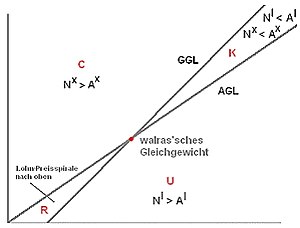Malinvaud regime
The regimes of Malinvaud , after Edmond Malinvaud , also known as regimes of economic situations, describe the connections between a goods market, a labor market and a money market in equilibrium. Wages are considered in relation to prices and the resulting demands and offers on the goods and labor markets.
Explanations
- w - price equilibrium (Walras equilibrium)
- K - Keynesian underemployment
- C - Classic underemployment
- U - under-consumption
- R - Suppressed Inflation
- GGL - The equilibrium line of the goods market , also known as the line of the goods market equilibrium, indicates all combinations of wages w and price p at which households demand just as many goods (output) as companies produce (offer).
- AGL - The equilibrium line of the labor market , also known as the line of the labor market equilibrium , indicates all combinations of wages w and price p at which households offer just as much labor as companies need to produce full employment output.
Keynesian underemployment
Companies and households are limited as providers on the goods market or on the labor market. Neither of the two can meet their initial demand.
Classic underemployment
Households are limited both on the goods market as goods demanders and on the labor market as labor providers. This economic situation is also characterized by the fact that companies produce less than households initially demanded due to high wages.
Underconsumption
Rarely occurring situation where companies are limited in both markets.
Suppressed inflation
There is excess demand in both markets, which is why there is often an upward wage-price spiral .
Mathematical basics
N l : = demand on the labor market A l : = supply on the labor market N x : = demand on the goods market A x : = supply on the goods market
- AGL: = N l = A l On the labor market, demand equals supply.
w = c·y·a·z(a – 1)
- GGL: = N x = A x On the goods market, demand corresponds to supply.
w = (p·y/(c·z)) – Ca
-
U - under-consumption
- N x <A x
- N l > A l
-
C - Classic underemployment
- N x > A x
- N l <A l
-
R - Suppressed Inflation
- N x > A x
- N l > A l
-
K - Keynesian underemployment
- N x <A x
- N l <A l
